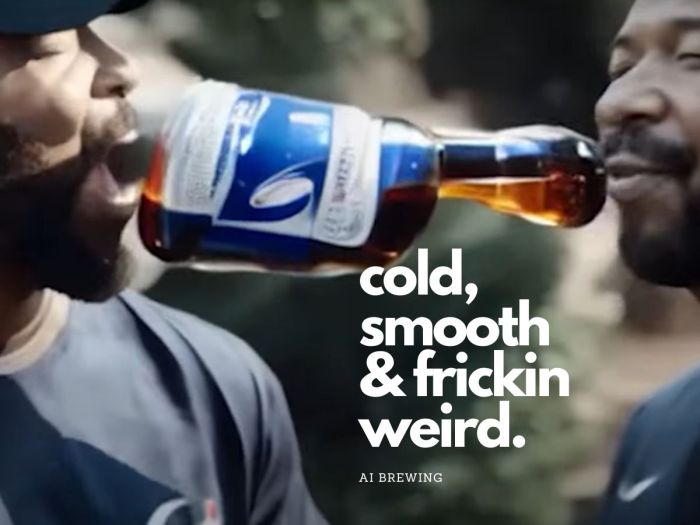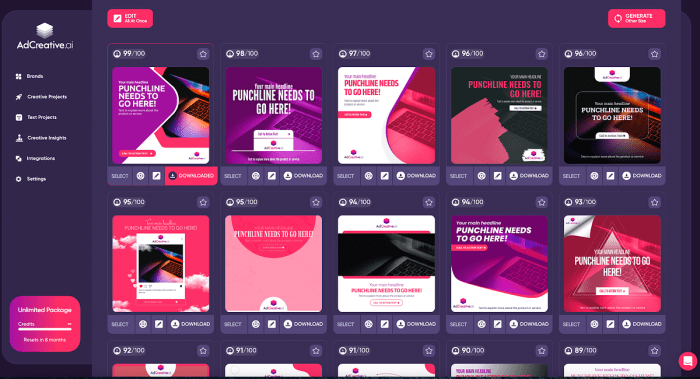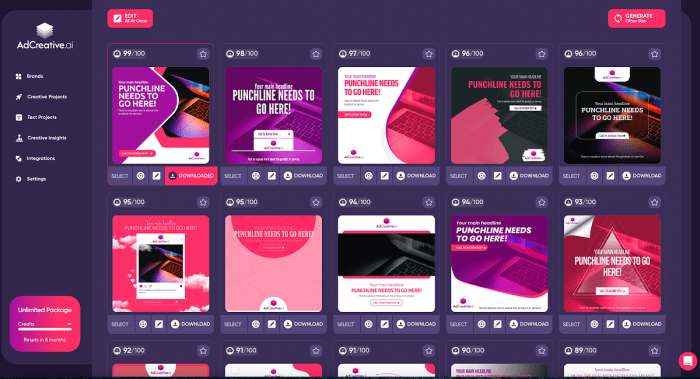The AI generated ads are coming, and the advertising industry is about to be revolutionized. Imagine a world where ads are perfectly tailored to your individual needs, anticipating your desires before you even know them. This isn’t science fiction; it’s the rapidly approaching reality of AI-powered advertising. From personalized recommendations to automated campaigns, AI is poised to transform how we interact with brands and products.
This shift will impact everything from marketing budgets to consumer behavior, and even the creative process itself. Get ready to dive into the fascinating world of AI-generated advertising.
This article explores the multifaceted impact of AI-generated ads, from their technical underpinnings to their potential effects on consumers and the advertising industry as a whole. We’ll examine the different types of AI-generated ads, how they compare to traditional methods, and the potential benefits and drawbacks of this emerging technology. Prepare to be amazed by the possibilities and consider the challenges that lie ahead.
Impact on Advertising
AI-generated ads are poised to revolutionize the advertising landscape, offering unprecedented personalization, automation, and targeting capabilities. This transformation promises to reshape how businesses connect with consumers, driving efficiency and potentially altering advertising budgets and spending patterns. The rise of AI in advertising is no longer a hypothetical concept; it’s a tangible reality impacting existing practices and creating new opportunities.The potential for AI to generate highly personalized and targeted advertising campaigns is immense.
Imagine ads tailored to individual consumer preferences, browsing history, and even emotional states. This level of granularity enables advertisers to reach the right audience at the right time with the right message, maximizing campaign effectiveness and minimizing wasted ad spend. This contrasts sharply with traditional, mass-market advertising methods that often miss the mark.
Personalized Advertising Campaigns
AI algorithms can analyze vast amounts of data to understand individual consumer behavior. This data includes browsing history, purchase patterns, social media interactions, and even location data. By leveraging this information, AI can create highly personalized ad experiences. For example, a clothing retailer could tailor an ad to a specific customer interested in a particular style of jeans, showcasing similar products they might be interested in.
Automation of Advertising Processes
AI can automate many stages of the advertising process, from ad creation to campaign optimization. AI-powered tools can generate creative ad copy, design visuals, and even select the optimal channels for reaching the target audience. This automation frees up human resources to focus on strategic planning and campaign management. The result is a significant boost in efficiency and cost savings for advertisers.
Impact on Advertising Budgets
AI-generated ads could potentially impact advertising budgets in various ways. On one hand, the increased efficiency and effectiveness of AI-powered campaigns could lead to cost savings. On the other hand, the initial investment in AI tools and the potential need for skilled personnel to manage these systems could create a higher entry barrier for smaller businesses.
Types of AI-Generated Ads and Their Uses
AI can be used to create a wide range of ad formats. These include display ads, video ads, social media ads, and even interactive experiences tailored to specific platforms. The applications span various sectors. For example, in the healthcare sector, AI-generated ads could target individuals with specific health concerns, promoting relevant services or products.
AI-generated ads are on the horizon, and it’s pretty exciting to think about the possibilities. Imagine the stunning visuals, and the sheer customization potential. Speaking of breathtaking visuals, check out this incredible time-lapse video of an orbit around Earth, captured by an ISS space tourist! iss space tourist captures breathtaking time lapse of an orbit around earth.
It just goes to show how far technology has come, and how these advances will likely shape the future of advertising. Getting ready for some seriously innovative ad campaigns!
Comparison of Traditional and AI-Generated Advertising
| Feature | Traditional Advertising | AI-Generated Advertising |
|---|---|---|
| Cost | Can be expensive, depending on the scale and channels used | Potential for cost savings through automation and targeted campaigns |
| Efficiency | Often less efficient due to less precise targeting | High efficiency due to targeted campaigns and automation |
| Targeting | Broad, mass-market approach | Highly personalized and targeted approach |
Challenges and Ethical Considerations
The widespread adoption of AI-generated ads brings forth potential challenges and ethical considerations. Issues such as data privacy, algorithmic bias, and the potential for manipulation need careful consideration. For example, AI algorithms trained on biased data could perpetuate stereotypes in advertising. These concerns necessitate robust ethical guidelines and regulations to ensure responsible AI implementation in advertising.
AI-generated ads are about to explode onto the scene, promising personalized experiences. But before you get caught up in the shiny new tech, consider your next phone purchase. If you’re looking to upgrade your tech, deciding between a carrier and unlocked Galaxy Note 8 might be a tough call. There are factors to weigh, like contract terms and future updates.
For a detailed breakdown on this, check out this helpful guide on should you buy carrier or unlocked galaxy note 8. Ultimately, these AI-driven ads will need devices like the Note 8 to function effectively, so making the right choice now could impact your future ad experience.
Consumer Response to AI-Generated Ads
AI-generated advertising is rapidly changing the landscape of marketing. Understanding how consumers react to these novel advertisements is crucial for businesses to leverage their potential effectively. Consumer response will be a complex interplay of factors, including familiarity with AI, perceived authenticity, and the potential for manipulation.
Consumer Reactions to AI-Generated Ads, The ai generated ads are coming
Consumer reactions to AI-generated advertisements are multifaceted and dynamic. Some consumers may be intrigued by the novelty and creative potential of AI-generated content, while others might be skeptical or even resistant. Factors like the perceived authenticity of the ad, the perceived skill of the AI in generating the content, and the context in which the ad is presented all contribute to the consumer’s overall response.
Influence on Consumer Behavior
AI-generated ads can significantly influence consumer behavior by tailoring messages to individual preferences and needs. Personalized recommendations, dynamic content adaptation, and targeted messaging can lead to increased engagement and conversions. However, a lack of perceived authenticity could lead to a negative response, potentially diminishing the impact on consumer behavior. For example, if an AI-generated ad for a new smartphone is too generic or doesn’t resonate with a consumer’s specific interests, it may fail to inspire purchase intent.
Trust and Distrust in AI-Generated Ads
Consumer trust in AI-generated ads is a significant factor. If consumers perceive these ads as authentic and trustworthy, they are more likely to engage with them and potentially make purchases. Conversely, if consumers feel manipulated or deceived by AI-generated content, they may develop distrust and avoid future interactions with ads from the same source. The ethical implications of AI-generated ads are paramount, especially when dealing with sensitive topics or vulnerable populations.
Privacy and Data Security Concerns
The use of AI in advertising necessitates careful consideration of privacy and data security. AI algorithms require vast amounts of data to function effectively, raising concerns about the collection, storage, and use of personal information. Consumers are increasingly aware of these concerns, and transparency and clear data policies are critical to maintaining trust. If consumers feel their privacy is compromised by AI-generated advertising, they are likely to be less receptive to future marketing efforts.
Comparison of Traditional and AI-Generated Advertising
Traditional advertising often relies on human creativity and intuition, whereas AI-generated advertising leverages algorithms and data analysis. Consumers may react differently to these two approaches. Traditional ads often evoke emotional responses through storytelling and human connection, while AI-generated ads may excel at personalized targeting and efficiency. The effectiveness of each method depends largely on the specific context and target audience.
AI-generated ads are definitely on the horizon, and it’s going to be fascinating to see how they evolve. Think about how much more personalized they could get, and how they’ll likely impact the way we consume information online. Meanwhile, the incredible advancements in audio compression, like Apple’s FLAC lossless audio compressed ALAC in iOS 11 apple flac lossless audio compressed alac ios 11 , are pushing the boundaries of what’s possible.
Ultimately, these technological leaps will likely shape the future of targeted advertising, making it even more refined and potentially even more intrusive.
Consumer Demographics and Potential Responses
| Demographic | Potential Response to AI-Generated Ads |
|---|---|
| Millennials | Likely to be more open to AI-generated ads, especially if they are perceived as creative and personalized. |
| Gen Z | Highly receptive to novel technologies and AI, potentially more engaged with interactive and personalized AI-generated ads. |
| Baby Boomers | May be more skeptical of AI-generated ads, requiring clear authenticity and transparency to build trust. |
| Gen X | Likely to respond favorably to AI-generated ads that are relevant and engaging, avoiding those that appear overly generic. |
| High-Income Consumers | Potentially more receptive to sophisticated and personalized AI-generated ads, especially if they offer unique and exclusive experiences. |
Impact on Consumer Choices and Purchasing Decisions
AI-generated advertising has the potential to significantly impact consumer choices and purchasing decisions by personalizing recommendations and tailoring content to individual preferences. Consumers are more likely to make purchases if they feel the products or services advertised align with their needs and interests. However, the long-term impact on consumer behavior remains to be seen. For instance, if AI-generated ads become overly intrusive or manipulative, it could lead to a backlash, negatively impacting consumer trust and purchasing decisions.
Creative Implications
AI’s potential to reshape advertising creativity is undeniable. From generating novel ad copy to designing captivating visuals, AI offers unprecedented opportunities for innovation. However, it’s crucial to recognize the interplay between AI’s capabilities and the enduring role of human creativity. This exploration delves into the potential benefits and challenges AI presents to the advertising landscape.AI can dramatically enhance the creative process by freeing up human designers from tedious tasks, allowing them to focus on higher-level strategic thinking and conceptualization.
This shift in focus can lead to more impactful and nuanced campaigns. Conversely, over-reliance on AI could lead to a homogenization of creative output, potentially diminishing the uniqueness and emotional resonance of advertising.
Potential for AI to Enhance Creative Advertising
AI tools can significantly speed up the design and production process. By automating repetitive tasks like generating different ad copy variations or creating various visual styles, AI empowers teams to explore a wider range of concepts and ideas. This accelerated creative process can lead to more diverse and experimental campaigns. For example, an AI could quickly generate numerous taglines for a new product, allowing marketers to select the most effective option.
Examples of AI-Powered Creative Campaigns
Several companies are already leveraging AI to create innovative advertising campaigns. For instance, some brands are using AI to personalize ad experiences for individual consumers, tailoring the messaging and visuals to resonate with specific demographics and preferences. Furthermore, AI is employed to analyze vast amounts of data to understand consumer behavior and tailor campaigns to their preferences. This data-driven approach can result in higher engagement rates and conversion rates.
Influence of AI on the Creative Process
AI can revolutionize the advertising creative process in several ways. It can assist in brainstorming, generating diverse ideas, and iterating on concepts. Tools capable of analyzing existing campaigns and predicting audience response can help marketers fine-tune their creative approaches.
Role of Human Creativity in AI-Generated Ads
Human creativity remains essential in the context of AI-generated ads. AI tools are powerful assistants, but they lack the emotional intelligence, cultural sensitivity, and nuanced understanding of human behavior that humans possess. Human creatives are crucial in guiding the AI’s output, ensuring the ads align with the brand’s values and resonate with the target audience. Human oversight is vital in ensuring ethical considerations are addressed, preventing biases, and maintaining a unique brand identity.
AI-Generated Ad Copy and Visuals
AI can generate unique ad copy and visuals by learning from vast datasets of existing creative works. It can analyze patterns, styles, and trends to create novel and engaging content. For example, AI could generate diverse taglines and slogans, incorporating relevant s and tone of voice. Similarly, AI can generate images, graphics, and video content that matches the brand’s identity and target audience.
Table: Comparison of AI-Generated and Traditional Creative Styles
| Creative Style | AI-Generated | Traditional |
|---|---|---|
| Abstract | Can generate complex visuals with diverse textures and shapes based on input parameters. | Relies on human interpretation and artistic expression. |
| Photorealistic | Can produce realistic images and videos with high detail, though may sometimes lack subtle nuances. | Emphasizes fine details and artistic skill to create authentic images. |
| Animated | Can generate animations with various styles and character designs based on user prompts. | Relies on skilled animators to bring characters and scenes to life. |
| Illustrative | Can create diverse illustrations with varying styles based on input parameters. | Emphasizes artistic talent to develop unique and evocative illustrations. |
Revolutionizing Ad Design with AI
AI’s potential to revolutionize ad design is vast. By automating repetitive tasks and providing access to a wider range of creative options, AI can empower designers to create more innovative and engaging advertisements. AI tools can generate multiple design variations in seconds, allowing designers to quickly explore different aesthetics and refine their ideas. This acceleration can result in faster turnaround times and reduced costs, enabling brands to experiment with new approaches more frequently.
Market Trends
The advertising landscape is rapidly evolving, and AI-generated ads are poised to reshape the industry. This shift isn’t just about technological advancement; it’s about a fundamental change in how brands connect with consumers. AI is automating tasks, personalizing experiences, and creating entirely new avenues for creative expression. Understanding the current trends, the pace of adoption, and the potential future is crucial for businesses navigating this transformative period.
AI Adoption in Advertising
The current state of AI adoption in advertising demonstrates a significant increase in experimentation and implementation. Companies are increasingly recognizing the potential of AI to enhance efficiency, improve campaign performance, and personalize customer interactions. From automated content generation to sophisticated targeting algorithms, AI is automating various aspects of the advertising process. This shift is particularly notable in areas like programmatic advertising and social media marketing, where AI-powered tools are streamlining the process of reaching specific audiences.
Future of AI-Generated Ads
The future of AI-generated ads looks promising, with projections indicating significant growth in the coming years. Advancements in natural language processing, image generation, and machine learning are enabling more sophisticated and engaging ad formats. Expect a greater emphasis on personalized experiences, hyper-targeting, and interactive content within advertisements. This shift will likely continue to increase the efficiency of ad campaigns and deliver more relevant content to consumers.
Companies Using AI-Generated Ads
Several companies are already leveraging AI-generated ads to enhance their marketing strategies. For example, companies like [Company A], a leading social media platform, are employing AI to personalize user feeds and suggest relevant ads. Similarly, [Company B], a digital advertising agency, utilizes AI tools to optimize ad campaigns in real-time, adjusting targeting and creative elements based on performance data.
These early adopters are demonstrating the practical applications of AI in advertising, which will be crucial for future developments.
Key Factors Driving AI Adoption
Several key factors are driving the adoption of AI in advertising. The need for increased efficiency and reduced costs is a primary motivator. AI tools can automate repetitive tasks, leading to significant time and resource savings. Furthermore, AI’s ability to personalize customer experiences and enhance targeting accuracy is crucial for brands seeking to maximize campaign effectiveness. Lastly, the availability of readily accessible and affordable AI tools is making it easier for businesses of all sizes to integrate AI into their marketing strategies.
Projected Growth of AI-Generated Ads
The table below illustrates the projected growth of AI-generated ads across various industries over the next five years. These figures are estimations based on current trends and anticipated advancements in AI technology.
| Industry | Projected Growth (2024-2029) |
|---|---|
| E-commerce | 45% CAGR |
| Social Media Marketing | 50% CAGR |
| Financial Services | 38% CAGR |
| Retail | 40% CAGR |
| Travel | 42% CAGR |
Impact on Marketing Job Roles
AI’s impact on marketing job roles is a complex issue. While some tasks may be automated, new roles focused on managing and overseeing AI-powered systems will likely emerge. Marketing professionals will need to adapt and acquire new skills to effectively utilize these technologies. Expect a shift in focus towards strategic planning, creative direction, and data analysis. This transition requires proactive skill development and continuous learning within the industry.
Technical Aspects: The Ai Generated Ads Are Coming

AI-generated advertising is rapidly evolving, fueled by advancements in machine learning and deep learning algorithms. This transformation demands a deep understanding of the underlying technical capabilities. The ability of AI to personalize, optimize, and scale ad campaigns is revolutionizing the industry, and understanding these technical aspects is crucial for anyone involved in advertising or marketing.The complexity of AI-driven advertising extends beyond simple ad creation.
It involves sophisticated data analysis, model training, and real-time adaptation to market fluctuations. These sophisticated systems enable advertisers to create targeted campaigns that are highly effective and yield superior returns on investment.
Algorithms and Models
Various algorithms and models power AI-generated ads. These models learn from massive datasets, enabling them to identify patterns and predict consumer behavior. Commonly used algorithms include recurrent neural networks (RNNs), convolutional neural networks (CNNs), and transformers. These algorithms are capable of understanding complex relationships within data, allowing them to generate creative ad content that resonates with specific audiences.
For example, RNNs excel at processing sequential data like text, enabling the generation of compelling ad copy.
Data Requirements
Training AI models for ad generation necessitates extensive data. This data encompasses a wide range of information, including consumer demographics, browsing history, purchase patterns, and engagement metrics. Data scientists and engineers meticulously prepare and curate this data to ensure its quality and suitability for model training. The volume and variety of data required are substantial. For instance, to generate effective video ads, models need training data encompassing diverse video formats, styles, and content.
Without sufficient and high-quality data, the models cannot perform accurately.
Data Scientists and Engineers
Data scientists and engineers play a pivotal role in the development and deployment of AI-generated ads. Their expertise is crucial for model training, data preprocessing, and performance optimization. They ensure the models are accurate, efficient, and scalable. They also need to stay abreast of the latest advancements in AI to maintain optimal performance. This includes adapting to new algorithms and models as they emerge.
Types of Data Used
Various types of data contribute to AI-generated ad creation. These include structured data (e.g., demographics, purchase history), unstructured data (e.g., social media posts, customer reviews), and semi-structured data (e.g., website clickstream data). These diverse datasets provide a comprehensive understanding of consumer behavior, enabling AI models to tailor ads effectively. For instance, incorporating user-generated content can lead to more authentic and engaging ads.
Technical Components of an AI-Driven Advertising Platform
The following table Artikels the key technical components of a typical AI-driven advertising platform:
| Component | Description |
|---|---|
| Data Ingestion and Processing | Gathering and preparing data from various sources. |
| Model Training and Optimization | Developing and refining AI models to generate ads. |
| Ad Generation and Personalization | Creating and tailoring ads based on individual user profiles. |
| Real-time Bidding and Optimization | Adjusting bids and ad placements in real time. |
| Performance Tracking and Analysis | Monitoring campaign performance and making adjustments. |
Real-Time Adaptation
AI models can adapt to real-time market changes. This adaptability is achieved through continuous learning and feedback loops. As market trends shift, the models adjust their parameters and strategies accordingly. This enables advertisers to maintain relevance and effectiveness in dynamic environments. For instance, if a particular becomes trending, the AI can automatically adjust ad copy to incorporate that , ensuring the ad remains timely and relevant.
Closure

The AI generated ads are undeniably changing the landscape of advertising. While the technology promises efficiency, personalization, and potentially groundbreaking creativity, it also presents new challenges related to consumer trust, privacy, and ethical considerations. The future of advertising will undoubtedly be shaped by this powerful tool. This article has offered a glimpse into the complex world of AI-generated ads, exploring the technological, creative, and consumer aspects of this rapidly evolving field.
The key takeaway is that adaptation and a nuanced understanding of the technology’s capabilities and limitations will be critical for success in this new era.




